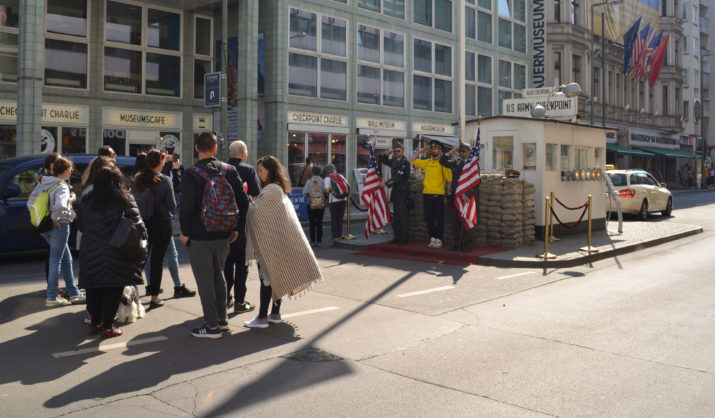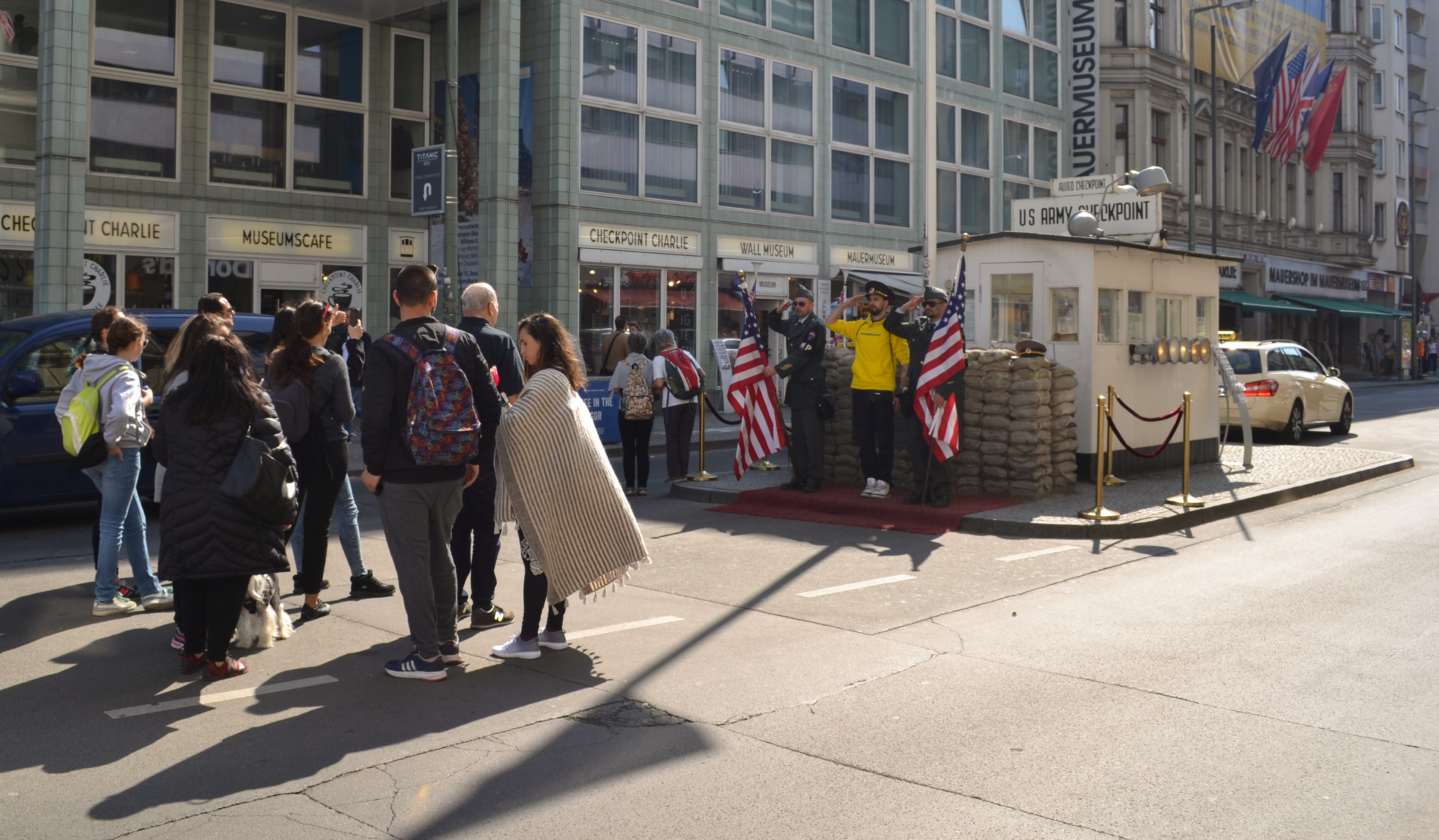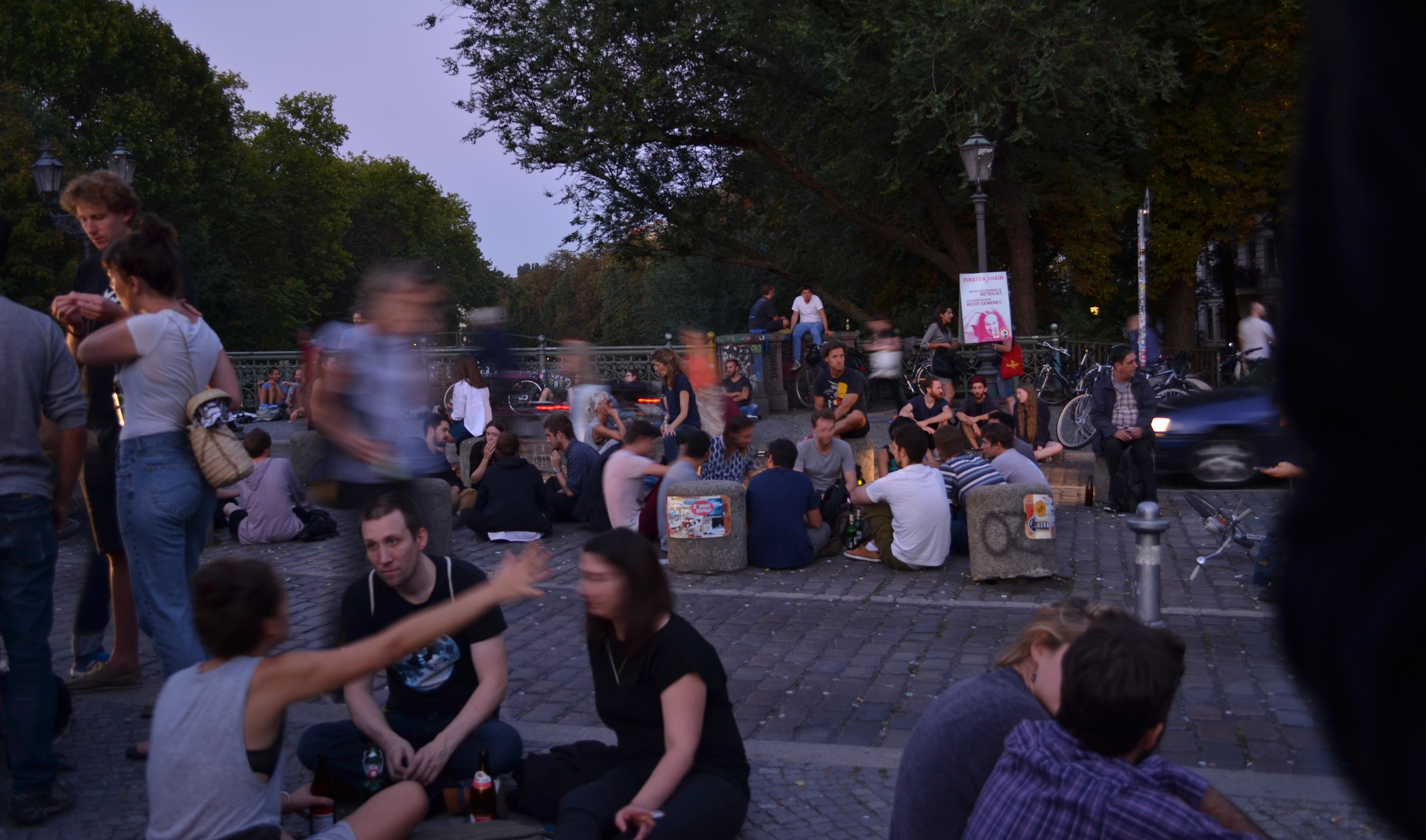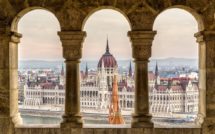
This is part of our special feature, Contemporary Urban Research in the European City.
Amidst the “overtourism” debate going on in Europe, one question pops up routinely. Namely, how much tourism do cities bear? This issue is a thought-provoking starting point to reconsider the interrelation of tourism and the city beyond the container-like idea of cities as destinations. Drawing on two examples from Berlin, this piece reflects upon tourism not as an isolated activity but as contested momentum co-producing urban places. The distinct controversies related to tourism at Checkpoint Charlie (a must see) and the Admiralbrücke in Berlin-Kreuzberg (an off-the-beaten track sight) prompt to frame these places as unbounded and continuously remade. Conceptually approaching tourism “beyond binaries,” it is exemplified that ideas of fixed container-like tourist places (sights), mutually exclusive doings (consumption/production) and distinct types of people (tourists/locals) fall short. It rather seems to be revealing to deepen research on urban tourist places as co-performed socio-material hybrids emerging where trans-/local processes intersect. This means, for instance, to further elaborate on, firstly, the interplay of visitors and materiality at tourist places and, secondly, the sociality to be found there. As a result of this, tourism appears not as something external, which is getting too much (“overtourism”), but as constituent of cities.
Approaching urban tourism beyond dichotomous categories
How much tourism do cities bear? Questioning the tourism capacities of cities implies a misleading understanding of the interrelation of tourism and the city. Cities appear as containers that impound only a certain amount of what destination managers often call “incoming tourism.” The idea of cities as destinations inhabited by locals and visited by visitors represents seems to be outdated. However, it represents a persistent figure of thought, albeit a quite simplifying one. The destination appears as place where visitors are tourists because they are away from home; where hosts encounter guests who consume what locals produce.
To be sure, such binary readings of tourism phenomena are already questioned in the sociology of tourism and in tourism studies (Hannam 2009). This is due to the “mobilities turn” in social sciences, which influenced tourism studies crucially (Rickly/Hannam et al. 2017: 1). Especially, the “new mobilities paradigm” (Sheller/Urry 2006) offered a dedicated perspective “to look at social phenomena [like tourism] through the lens of movement” (Salazar 2017: 248). This perspective frames tourist places as unbounded and hybrid. There are “diverse mobilities and proximities, flows of anticipations, performances, and memory as well as extensive social-material networks stabilizing the sedimentated practices that make tourist places” (Bærenholdt et al. 2004: 2). The latter reading of tourist places transgresses clear-cut and mutually exclusive categories used to describe destinations or sights as geographically fixed entities, where certain types of people (e.g. locals/tourists) are involved in a distinct manner (e.g. produce/consume). These conceptual considerations not least find terminological expression. There exist some telling notions, which reflect the aim to approach tourist places and practices in a more holistic way. Tourist places are framed as “host-guest-time-space-cultures” (Sheller/Urry 2004: 6); the notion of “city users” (Costa/Martinotti 2003: 60) was introduced to term temporary urban populations constituted by a broad range of visitors (e.g. expats, business travelers, interns and students) or, referring to Toffler, tourists are approached as “prosuming creative urban areas” (Pappalepore et al. 2014: 227, emphasis added).
Referring to this conceptual teaser, urban tourism phenomena seem to highlight how binary categories lose explanatory grip. A brief look at “VFR-Tourism” (Visiting Friends and Relatives)[1] and “New Urban Tourism” exemplifies how binaries like extraordinary tourism vs. everyday life, host vs. guest, leisure vs. tourism or production vs. consumption blur.
It would fall short to frame “VFR-Tourism” solely as extraordinary escape from everyday life (Larsen 2008). Surely, the breakfast shared with the relatives/friends visited may be more sumptuous. However, socializing (pleasantly) with co-travelling family members or friends is definitely not a pure extraordinary tourism activity. Such “VFR-travelling” is essentially about realizing family or social life at-a-distance. This could include obligations to see one another as well as willing support in housework or childcare. Everydayness enters “VFR-tourism.” Plus, if the hosts join their guests for breakfast out, don’t they themselves “act as if tourists” in their own cities (Lloyd/Clark 2001: 357)? The difficulties to discern tourists from locals also apply to people seeking to find the real city off the beaten track. It is the intensity of this genuine tourist interest in certain aspects of local everyday life, which has increased awareness of “New Urban Tourism” as a phenomenon in its own right (Dirksmeier/Helbrecht 2015). The latter is not easy to identify because people doing what researchers call “New Urban Tourism” are often experienced city users who “want to fit in, rather than stand to one side” (Maitland/Newman 2009: 135). Nevertheless, one could record that also places of “New Urban Tourism” are “places in which overlapping activities of tourism and leisure now form part of its [the cities] fabric and life“ (Maitland 2010: 176). “New Urban Tourism” consumes and produces the urban.
Hence, now that visitors are out to live like a local and locals act as if tourists, we should ask: What begins beyond thinking of urban tourism in terms of binaries? And, what do controversies about urban “overtourism” tell us about all that?
The trans/-local co-production of tourist places: conflicts as signifiers
Considering blurring borders between the clear-cut categories of tourism research, I argue that the debate about “overtourism” sparks pondering on urban tourism anew. The “overtourism” controversies envision that tourism matters beyond its well-known economic effects (taxes, jobs, etc.). Tourism-induced conflicts signify that tourism is not a discrete and isolated activity but co-produces the urban. Even more, particularly tourism-related conflicts make the trans-/local entanglement of cities and tourism present. This trans-/local entanglement of cities and tourism is getting visible where trans-local and local processes intersect in a divisive manner. Two examples may help to illustrate this thought:
Firstly, think of the “peer-to-business-to-peer” (van de Glind 2015) homesharing platforms, which interlink trans-local and local forms of economic activity. The companies manage accommodations globally; mobilize global flows of money/taxes and structure the way travelers dwell. This works because people worldwide commodify their local housing space. Hence, it is the local housing market where these trans-/local processes intersect and a contentious matter of concern related to tourism emerges. Namely, the conversion of apartments into “pure” holiday flats which is criticized against the backdrop of a rising rents, gentrification and tight housing markets (Novy/Colomb 2017). Secondly, think of Berlin’s destination and culture marketing campaign with the tagline “365/24 Berlin.” This campaign, saying that there is always something interesting going on in Berlin, is launched worldwide (e.g. in the media, at trade shows) to compete for potential visitors. Locally in turn, the message is criticized as invitation to party “24/7” in the neighborhoods. In this case, disparate local and (intended) trans-local readings of the campaign make it a contested narrative; the trans-locally oriented campaign is criticized for its potential local effects.
Such trans-/local tourism-related processes take place and shape the urban of course not only within a purely discursive arena. In fact, trans-/local forms of tourism related “city making” continuously spawn concrete urban places. This is what will be detailed exemplarily in the next section. The first example, the Checkpoint Charlie, represents an inner-city must see. The most famous former crossing point between East and West Germany currently sparks (again) a semi-public debate about how this heritage site/sight should be developed. The second example is located off the beaten track. The happening-like evening socials at the Admiralbrücke in Berlin-Kreuzberg show that they are co-performed by visitors and locals alike. Yet, the case of the Admiralbrücke has been contested, for example due to nightly noise disturbances or pollution through garbage.
Checkpoint Charlie: Material affordances and fixings of an unbounded touristscape
Without doubt, the former border crossing Checkpoint Charlie could be considered to be one of the most popular heritage sites in Berlin. Thousands of people visit the museums and (temporary) exhibitions located on the spot each year. They listen to the explanatory notes of their guides; enjoy taking photos with actors dressed up as border guards (image 1); eat in the restaurants nearby and so on. This tourism is not an unquestioned matter of course. Since the removal of the border installations in 1990, the daily tourism-related occurrence at Checkpoint Charlie has triggered some controversies about the “right” culture of remembrance on site. When it comes to the status quo or future perspectives of the place, some see or fear “Disneyfication,” others elitism (Frank 2011). So, the question at stake is how the “right” culture of remembrance on site should look like. And, for the purpose of this piece: What does this question tell us about the trans-/local entanglement of the city and tourism?

Image 1, Performances of photography at Checkpoint Charlie, credits: C. Sommer
Answering this question leads at first to the observation that the “right” culture of remembrance is apparently intimately linked to the material setting of the scenery. It is noteworthy that local disputes about the appropriate way the site/sight should be used are constituted around these distinct material (re-)configurations. I will detail that referring to the reconstructed checkpoint booth as well as to a planned Hardrock Hotel. Firstly, I elaborate on the material affordance of the checkpoint booth, which triggers the performative co-production of the place by tourists. Thereby, the translocality of the place will become visible in terms of globally informed modes of touring sights in an experience-oriented manner. The latter typify the place inevitably. Secondly, I show another dimension of the translocality of the place: The undeveloped lots on sites attract global tourism-related tourism facilities like e.g. the planned Hardrock Hotel. The latter interlinks, in turn, a globally sought experience promise with memorabilia of music culture. Both infrastructures, the booth a well as the planned hotel, are specifically related with a “Disneyfication” blame.
So, the reconstructed checkpoint booth and its material “affordance” (Gibson 1966, quoted from Edensor 2007: 206) is the issue to start with. The term affordance gears towards the “material textures of space […] which provide[s] spatial potentialities, constraining and enabling a range of actions (ibid., emphasis in the original). In this sense, the booth at Checkpoint Charlie has agency; it invites visitors to take pictures. As an essential set piece of the place it determines the “tourist gaze” upon Checkpoint Charlie – because this “tourist gaze” is crucially constructed through performances of photography (Urry/Larsen 2011). At Checkpoint Charlie the art of tourist photography is prototypically exemplified since what matters here is to “place one’s ‘loved ones’ within an ‘attraction’ in such a way that both are represented aesthetically” (Urry/Larsen 2011: 179). These performances of photography co-produce the scenery. One can observe that visitors habitually touring heritage sites/sights in an experience-oriented manner do appreciate the scenery and thereby they bring it into being. The performances of photography inevitably typify Checkpoint Charlie according to intercontinentally informed modes of touring heritage sites/sights. However, in the reporting on Checkpoint Charlie exactly this extensive doing of photography triggers reservations. Putting the reconstructed border infrastructures and re-enacted border guards into the picture is disqualified as a trivial doing that fosters “Disneyfication.”
Currently, this tendentious term is also made use of in the course of a semi-public debate about the future of two undeveloped building plots located at Checkpoint Charlie. The planned Hardrock Hotel, which most likely will be built on one of the lots, triggers the
“Disneyfication” blame less due to trivial tourism performances but to a feared standardization. This feared standardization also signifies the translocality of the place. Nevertheless, also this controversy is revealingly linked to the material setting of the place, better: the potential of the empty space. Currently, the latter is “in play” with capital flows of the real estate business as well as the tourism industry. Hence, the planned Hardrock Hotel represents how urban tourist places emerge in the conjuncture of trans-/local processes. At “unique locations“ (Hard Rock Cafe International Inc. 2018), like Checkpoint Charlie, the hotel project interlinks a globally sought experience promise with memorabilia of music culture. In this sense the hotel illustrates how tourism places truly organize a multiplicity of intersecting mobilities, which typify their unbounded character (Bærenholdt et al. 2008).
Admiralbrücke in Berlin-Kreuzberg: Co-Performing urban hangout commons
In opposition to Checkpoint Charlie, which is an inner-city tourist attraction, it is in the neighborhood spaces that most of the conflict potential of tourism is harbored (Sommer/Helbrecht 2017). At stake are for instance nighttime noise, littering, the conversion of rental apartments into holiday flats or feelings of alienation by some residents. Hence, the second case I refer to is located off the beaten track, in an area that tourism researchers would label a “New Tourism Area” (Maitland/Newman 2004: 339). In short, the Admiralbrücke in Berlin-Kreuzberg is a small traffic-calmed bridge and the stage for happening-like summertime gatherings[2] of (nowadays) up to 300 people (image 2). To be sure, the Admiralbrücke represents not an isolated case; similar hang-out spots exist in other European cities as well.

Image 2, Co-Performing evening socials at Admiralbrücke in Berlin-Kreuzberg, credits: C. Sommer
One stereotype, which is frequently invoked in the controversy at stake, is that tourists are the ones causing the noise conflicts (see e.g. mediation report StreitEntknoten 2010). So, the initial questions are: who is actually taking part in the summertime gatherings on site and what does this tell us about the trans-/local entanglement of the city and tourism?
Albeit there exist no large-scale surveys regarding the types of people gathering at the bridge, some smaller analyses show that a high share of the people hanging out there are locals (Kaschuba 2014). Also ethnographic site visits, conducted by the author, indicate that the gatherings at Admiralbrücke are co-produced by a broad range of (temporary) city users like neighbors, Berliners, expats, interns, tourists and so on (Sommer/Kip 2019). Hence, the scenery is co-performed as (contested) collective good – “as an aggregation of individual interests to participate in a collective endeavor that is neither driven by economic nor regulatory interests” (ibid. 6). Whereby, the experience of collectivity is typified both by relative anonymity and the prospect of unforeseen contacts. All in all, two essential promises seem to structure the appeal of this (tourist) place. Namely, for one, to be part of some kind of temporary happening-like group experience. Plus, it seems to be equally important to experience the urban outdoors by itself. Nevertheless, the case at stake, performed by temporary chill-out communities manifests the determining role material configurations play in the ongoing re-production of “New Urban Touristscapes.” The performance perspective highlights, regarding the gatherings on Admiralbrücke, that “the spatiality of the scenery is emphatically experienced, affectively understood and physically incorporated and enacted” (Helbrecht/Dirksmeier 2013: 285). Think for example of the bollards in the middle of the bridge (Image 2) which originally haven been installed to reduce car traffic on it. Nowadays, they serve as seats. In this sense, the bollards cannot be reduced to merely passive carriers of meanings – they afford to sit on them.
Synopsis: Co-performed and unbounded but materially fixed touristscapes
The tourism-related happenings at Checkpoint Charlie and the Admiralbrücke exemplify what is theoretically elaborated regarding the complexity and unboundedness of tourist places. The particular controversies related to tourism at Checkpoint Charlie and the Admiralbrücke prompt revealing questions. In case of the former the key question at stake is: How should the “right” culture of remembrance on this (tourist) sight/site look like? Regarding the happening-like evening socials at Admiralbrücke, it is routinely asked: Who is actually taking part in the noisy summertime gatherings on site?
The observations triggered by these questions illustrate what advanced conceptualizations of tourist places claim. In particular, two observations help to understand Checkpoint Charlie and Admiralbrücke as co-performed and unbounded but materially fixed hybrids “bridging the realms of humans and nonhumans” (Bærenholdt et al. 2004: 2). Both considerations, which I sum up hereafter, build the basis for my conclusions regarding future research on urban tourism beyond binaries.
Firstly, urban tourist places emerge where trans-/local processes intersect; they are brought into being by performances of tourists and other temporary city users. Conflicts ascribed to tourism signify such intersections and co-productive performances. In case of Checkpoint Charlie, divisive ideas of how to visit a heritage site/sight encounter. Co-producing the site/sight through experience-oriented performances of photography triggers some reservations on the part of those who would prefer more cautious site visits. Nonetheless, Checkpoint Charlie is inevitably typified by globally informed performances of tourist photography. Plus, the inner-city must see is shaped by the flows of money mobilized and locally fixed by the global tourism industry and its experience promise – in this case by the Hard Rock Cafe International Inc. The plan of the latter to build a Hotel is contested due to the increasingly standardized facilities crystalizing on site (McDonald’s, KFC etc.). In case of the Admiralbrücke, tourists are frequently blamed for the noisy gatherings on site. However, research shows that a broad range of visitors (from other parts of town or the world) co-produces the happening-like evening socials – which are contested but also continuously attracting temporary urban chill-out communities.
Secondly, both examples render visible the determining role local material set pieces (immobilities) of tourist places play. With Sheller/Urry one could record that the reconstructed checkpoint booth as well as the bollards on the Admiralbrücke represent objects “that contingently fix certain networks of play and pleasure” (2004: 6). At Checkpoint Charlie, the material infrastructures trigger performances of photography, and, in the future, ways of tourist dwelling according to the global Hardrock brand promise. The material set pieces of the happenings at Admiralbrücke cannot be reduced to merely passive carriers of meanings and sign-value. The bollards’ affordance to lean on them is a striking example of this significance of materiality. Not least, the controversies related to the cases at stake seem to be intimately linked to the material fixings of these unbounded tourist sites/sights.
Conclusion: What begins at the end of urban tourism, as we know it?
For sure, the entanglement of cities and tourism is on the agenda of tourism/urban studies. There exists fruitful research on “Protest and Resistance in the Tourist City” (Colomb/Novy 2017), the interrelation of “Tourism and Gentrification in Contemporary Metropolises“ (Gravari-Barbas/Guinand 2017) or the entanglement of “Tourism and Everyday Life in the Contemporary City[3]” (Frisch/Sommer et al. 2019). With regard to the deliberately chosen examples at stake in this piece, there are – however – two issues, which in general need to be elaborated in more detail (conceptually and empirically). This is the socio-materiality of tourist places as well as their sociality as joyful urban sceneries.
According to Cohen/Cohen’s review article on ‘New Directions in the Sociology of Tourism’ (2017) the literature confirms the need to conceptually detail the significance of materiality in research on tourism. However, it is neither ANT alone, nor a sole focus on objects, which informs this aspiration (like Cohen/Cohen record). On the one hand, taking materiality conceptually into account stems from a broader understanding of space as “agentified.” The latter builds e.g. on STS, assemblage thinking or the social anthropology of Tim Ingold (Niewöhner 2014). On the other hand, drawing on performance and on Ingold’s work (e.g. on ‘taskscapes’) to approach tourist places necessarily means to take materiality seriously. Bærenholdt et al. for example stress that tourist places could be understood as “hybrid artefacts, drawing together mobilities and proximities that crosscut the realms of the social and the material” (2004: 6). It is recorded that “places are (re)produced through systems of tourist performances, made possible and contingently stabilized through networked relationships with other […] buildings, objects and machines” (ibid.: 151). Hence, it is misleading, like Ingold (2010) shows, to stick to the question if objects have agency. What needs to be detailed empirically is rather how tourist performances relate to materiality in concrete terms. After all, this is a defining strength of the performance approach, which highlights that actions are not conceivable without taking stages, décor or set pieces into account. Regarding urban tourist places, it seems to be promising and necessary to detail how this “spacing” (Crouch 2003: 1953) as “the constitutive part of performativity in the relation to surroundings” (ibid.) empirically looks like. Maybe the notion of “urban assemblages” (Farias 2009) offers a powerful foundation to do so. This approach gears to grasp the city as continuously assembled at concrete sites of urban practice. It claims to keep in mind, how “the city and urban life are literally being reconstructed and remade, how urban materials, technologies and different urban life forms are composed and hold together in practice” (Farias 2011). Urban “must sees” (like Checkpoint Charlie) represent promising cases to conduct urban (tourism) studies interested in the socio-materiality of tourism-related urban sceneries.
The second issue, which seems to be sparking for future urban (tourism) studies, results from the observation that studies “considering the intersection between performances of tourists and locals within the frame of conflict […] and opposition […]” offer “only a limited account of the possible outcomes of these encounters” (Giovanardi et al. 2014: 104). For sure, it is acknowledged that “overlapping activities of tourism and leisure now form part of its [the cities] fabric and life” (Maitland 2010: 176). But, what is emerging there concretely? The case of Admiralbrücke tentatively frames the happening-like hangout practices as kind of urban commons (Sommer/Kip 2019). The temporary chill-out communities, constituted by a broad range of city users, co-perform a (contested) social good. From an empirical point of view, it seems to be interesting to pin down further manifestations of the productive momentum of tourism-related performances, flows and mobilities – which represent constituents of cities beyond abstract economic effect (taxes, jobs) and conflicts. Conceptually, the case of Admiralbrücke confirms to further transgress the dualism of exotic others and significant others (Larsen 2008). Not only family members and friends represent significant co-travelling others, but also co-dwelling urbanites seem to do so.
So, what begins at the end of urban tourism, as we know it? This is an open question in a positive sense. Hopefully, the exemplary cases presented in this piece show that there is a lot to discover beyond an understanding of tourism in terms of binaries. Urban (tourism) studies would profit – empirically and as well conceptually.
Christoph Sommer works at the interface of urban studies and consulting (recently: Tourism Strategy for Berlin). He holds a diploma in Geography from LMU München and is currently pursuing his PhD at Humboldt University Berlin. He is co-founder and member of the “Urban Research Group New Urban Tourism” at the Georg Simmel Center for Metropolitan Studies.
References
Bærenholdt, J.O., Haldrup, M., Larsen, J., Urry, J. (eds.) (2004) Performing Tourist Places. Hants/Burlington: Ashgate.
Cohen, S.A., Cohen, E. (2017) New directions in the sociology of tourism. Current Issues in Tourism. Published online: 08 Jul 2017.
Costa, N., Martinotti, G. (2003) Sociological Theories of Tourism and Regulation Theory. in: Hoffman, L.M., Fainstein, S.S., Judd, D.R. (eds.) Cities and Visitors. Regulating People, Markets, and City Space. Malden/Oxford/Carlton: Blackwell, pp. 53–71.
Crouch, D. (2003) Space, Performing, and Becoming: Tangles in the Mundane. Environment and Planning D: Society and Space 35, pp. 1945–1960.
Dirksmeier, P., Helbrecht, I. (2015) Resident Perceptions of New Urban Tourism: A Neglected Geography of Prejudice. Geography Compass, 9(5), pp. 276–285.
Frank, S. (2011) Der Mauer um die Wette gedenken. Aus Politik und Zeitgeschichte 61(31-34), pp. 47–54.
Gibson, J. (1966) The Senses Considered as Perceptual Systems, cited in Edensor, T. (2007) Mundane mobilities, performances and spaces of tourism. Social & Cultural Geography 8(2), pp. 199–212.
Giovanardi, M., A. Lucarelli, P. L’Espoir Decosta (2014) Co-performing tourism places: The “Pink Night” festival. Annals of Tourism Research 44, pp. 102–115.
Hannam, K. (2009) ‘The end of tourism? Nomadology and the mobilities paradigm’, in: J. Tribe (ed.) Philosophical issues in tourism. Bristol: Channel View, pp. 101–113.
Hard Rock Cafe International Inc. (2018) Available at: http://www.hardrock.com/cafes/ URL [Accessed 10. Apr. 2018].
Helbrecht, I., Dirksmeier, P. (2013) Stadt und Performanz. in: Mieg, H., Heyl, C. (eds.) Stadt. Ein interdisziplinäres Handbuch. Stuttgart: J.B. Metzler, pp. 283–298.
Ingold, T. (2010) Bringing Things to Life: Creative Entanglements in a World of Materials. NCRM Working Paper Series 5/2010, ESRC National Centre for Research Methods. Available at: http://eprints.ncrm.ac.uk/1306/1/0510_creative_entanglements.pdf [Accessed 10. Apr. 2018].
Kaschuba, W. (2014) Kampfzone Stadtmitte: Wem gehört die City?, in: Jessen, J. (ed.): Altstadt für Alle? Urbanität als Zumutung, Zeitschrift FORUM Stadt (4/2014), pp. 357–376.
Larsen, J. (2008) De‐exoticizing Tourist Travel: Everyday Life and Sociality on the Move. Leisure Studies, 27(1), pp. 21–34.
Lloyd, R., Clark, T.N. (2001) The City as Entertainment Machine. in: Gotham, K.F., (ed.), Critical Perspectives on Urban Redevelopment. Amsterdam: Elsevier Science.
Maitland, R., Newman, P. (2004) Developing Metropolitan Tourism on the Fringe of Central London. International Journal of Tourism Research, 6(5), pp. 339–348.
Maitland, R., Newman, P. (2009) Conclusions. in: R. Maitland, P. Newman (eds.) World Tourism Cities. Developing tourism off the beaten track. London/New York: Routledge, pp. 134–142.
Maitland, R. (2010) Everyday life as a creative experience in cities. International Journal of Culture, Tourism and Hospitality Research 4(3), pp. 176–85.
Niewöhner, J. (2014) Raum. Anthropologische Perspektiven. in: J. Oßenbrügge, A. Vogelpohl. (eds.) Theorien in der Raum- und Stadtforschung. Münster: Westfälisches Dampfboot, pp. 14–23.
Novy, J., Huning, S. (2009) New tourism (areas) in the ‘New Berlin’. in: R. Maitland, Newman, P., (eds.) World Tourism Cities. Developing tourism off the beaten track. New York/London: Routledge, pp. 87–108.
Novy, J., Colomb, C., (eds.) (2017) Urban tourism and its discontents: an introduction. in: Protest and Resistance in the Tourist City. Oxon: Routledge.
Pappalepore, I., Maitland, R. und Smith, A. (2014) Prosuming creative urban areas. Evidence from East London. Annals of Tourism Research, 44, pp. 227–240.
Rickly, J., Hannam, K., Mostafanezhad (eds.) (2017) Introduction: ‘new’ tourism and leisure mobilities – what’s new? in: Tourism and Leisure Mobilities. Politics, work, and play. Oxon: Routledge, pp. 1–13.
Salazar, N., B. (2017) Afterword. in: Rickly, J., Hannam, K., Mostafanezhad, M., (eds.) Tourism and Leisure Mobilities. Politics, work, and play. Oxon: Routledge, pp. 248-252.
Sheller, M., Urry, J. (2004) Tourism Mobilities. Places to play, places in play. London: Routledge.
Sheller, M., Urry, J. (2006) The new mobilities paradigm. Environment and Planning A 2006, 38, pp. 207–226.
StreitEntknoten (2011) Abschlussbericht Mediationsverfahren Admrialbrücke. Ed.: Azad und Wietfeldt GbR.
Sommer, C., Helbrecht, I. (2017) Seeing like a tourist city: how administrative constructions of conflictive urban tourism shape its future. Journal of Tourism Futures 3(2) pp.157–170.
Sommer, C., Kip, M. (forthcoming) Commoning in New Tourism Areas: Co-performing evening socials at Admiralbrücke in Berlin-Kreuzberg. in: Frisch, T., Sommer, C., Stoltenberg, L., Stors, N. (eds.) Tourism and Everyday Life in the Contemporary City. Oxon: Routledge.
Urry, J., Larsen, J., (2011) The Tourist Gaze 3.0. London: Sage.
van de Glind, P. (2015) The Rise of the ‚Peer-to-business-to-peer’ Marketplace. Available at: http://www.sharenl.nl/nieuws/the-rise-of-the-peer-to-business-to-peer-marketplace [Accessed 10. Apr. 2018].
visitBerlin (2017) Wirtschaftsfaktor 2016 für Berlin. Available at: https://about.visitberlin.de/sites/default/files/2017-08/Wirtschaftsfaktor%20Tourismus-%20und%20Kongressindustrie.pdf [Accessed 10. Apr. 2018].
[1] In Berlin, VFR-Tourism accounts for most of the annual overnight stays (visitBerlin 2017)!
[2] Think e.g. of the Plaza Del Dos de Mayo (Madrid), Piazza Dell’immacolata (Rome), Gärtnerplatz (Munich), the Canal Saint-Martin (Paris) or the Colonne di San Lorenzo in Milan.
[3] Forthcoming anthology, co-edited by members of the Urban Research Group New Urban Tourism at the Georg Simmel Center for Studies (HU Berlin)
Published on May 1, 2018.




